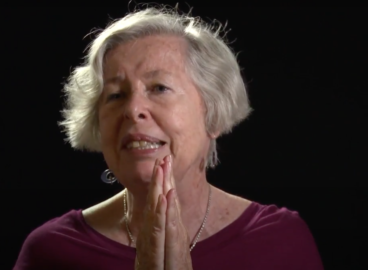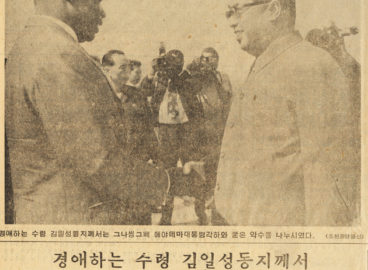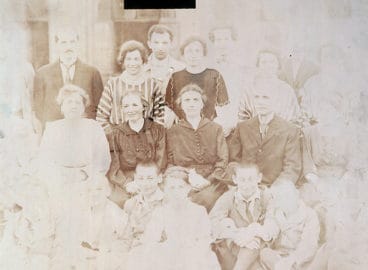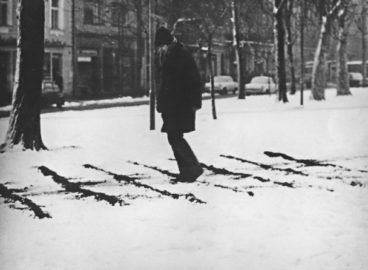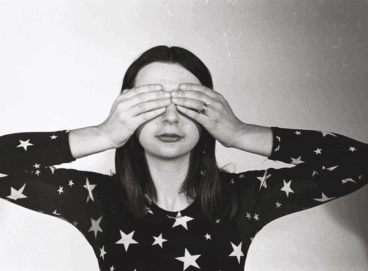“A Raven Will Not Pick Out Another Raven’s Eye… Etc.”
Authors Jarosław Kozłowski
Date December 1976
Publication RelARTacje: Dni Autorskie : Dłusko 2-11 Luty 1977
Publisher Poznań: Socjalistyczny Związek Studentów Polskich Zarząd Wojewódzki, 1977.
Language Polish
Links http://www.worldcat.org/oclc/316447734
It can be imagined – based on real facts – that certain green objects will in the future change their color to blue, while other green objects will remain green. The former, changing their color from green to blue, could then be simply called “grue” (“green” + “blue”); only the latter would retain the name “green.”
Similarly, certain blue objects may also at some point change their color to green, while other blue objects will remain blue. Analogously, those objects whose color changes from blue to green can then be called “bleen” (“blue” + “green”); all the other ones would retain the name “blue.”
Now a problem arises: how to now distinguish what is blue from what was once blue but underwent a change to bleen, and how to distinguish what is green from what was once green but underwent a change to blue. Moreover: how to distinguish what is bleen from what is green and what is blue from what is blue, and also: how to distinguish what used to be green but underwent a change to grue and how in that case to distinguish green from blue and vice versa at the moment of the transition of green to grue, and blue to bleen; and finally, what really is this bleen and blue in light of the assertion regarding the exclusion of colors, e.g. “Nothing can be wholly green and blue at the same time and for the same observer.”
The paradox of g r u e is one of two paradoxes of induction that interests us here. The other one – formulated a bit earlier – is Hempel’s raven paradox.
Hempel noticed that if we adopt a generalization of the kind “All ravens are black” and try to confirm that assertion through induction, i.e. through a reasoning in which a proposition that constitutes a general rule is recognized based on earlier propositions that include all the individual cases falling under that same rule, then we have to accept that the assertion: “No objects that are not black can be ravens” corresponds to that assertion. The same is true for the assertion “Whether or not something is a raven: if it is a raven, it’s black.” In this way, whatever confirms one of the assertions by the same token also confirms the other ones, and vice versa. Accordingly, to identify any black raven, any non-raven, or any object at all confirms the initial generalization: “All ravens are black,” which contradicts common sense.
The strength of Hempel’s paradox lies in the supposed impossibility of finding any convincing logical objections to counting a gray sparrow, a brown chair, a sunset or a black piano among examples confirming the statement that all ravens are black. Let us now refer to one of Joseph Kosuth’s recent theoretical texts, published in the second issue of The Fox magazine in 1975. Titled “1975”, the text is an explication of the new ideological orientation of Kosuth himself as well as, to a greater or lesser degree, of the whole group of artists associated with the periodical, including the British collective Art & Language. Interestingly, this new artistic paradigm (although the adjective “new” isn’t a precise term here and should be construed relatively – new versus the previous one, which in Kosuth’s case is encapsulated in his famous formula of “art as an idea, as an idea”) immediately found followers also in Poland, who either subscribed to the general ideological line of The Fox, but not without at the same time patronizingly stressing that their own achievements had anticipated it (vide Stefan Morawski), or emphasized its parallels with their own agendas (Jan Świdziński and his program of contextual art – “Art as Contextual Art”). By the way, it is worth remembering that in the 1950s both Morawski and Świdziński actively partook in so called “Socialist Realism,” so their engagement with the issues outlined by The Fox might seem an example of admirable consistency, were it not for the fact that both gentlemen had at some point categorically disowned that ideology. For all that, they continue disowning it today, disguising their crypto-socialist-realist art theories in the jargon of 1970s modernity, and resorting to a somewhat different set of classic philosophers.
In the text in question, Kosuth defines art as follows: “Art is a description of reality by way of an interpretation of tradition. It is in the interpretation that one judges the value of the activity — as a real depiction of the social reality. In this sense ‘real’ work is a historical fusion of an individual’s (or individuals’) lived reality with the constituted ‘optimism’ inherent in a civilization’s ethnology”1Editor’s Note: The text is also accessible in Joseph Kosuth: Art After Philosophy and After. Collected Writings, 1966-1990. Cambridge, Mass.: Massachusetts Institute of Technology Press, 1991, p. 141. Elsewhere, he adds, “If art is context-dependent (as I’ve always maintained) then it cannot escape a sociopolitical context of meaning” (The Fox, no. 2).2Ibid., p. 141. From the above statements by Kosuth, let us select and examine for example the statement, “Art is context dependent.”
Assuming, for simplicity’s sake, that the term “art” denotes the set of all possible artistic facts, the above statement can be formulated as: “All artistic facts are context dependent.”
Let us assume that, just as with ravens, there exist specific examples confirming the above observation, and that the notion that all artistic facts are context dependent is a common notion, one that we can agree with, just as we agree that all ravens are black.
Analogously, the statement “all artistic facts are context dependent” is equivalent to “all objects that are not context dependent are not artistic facts,” and to “if something is or isn’t an artistic fact, then, if it is an artistic fact, it is context dependent.” And since if anything confirms any of the statements, it confirms the other ones, too, and vice versa, pointing to any artistic non-fact that isn’t context dependent or any other object confirms the initial statement: “all artistic facts are context dependent.” As has already been stated in connection with ravens, such reasoning is paradoxical—counter-intuitive— for it would mean that a gray sparrow, the chair I’m sitting on, the setting sun, or the very fact that I’m saying something are examples confirming the assertion that all artistic facts are context dependent. Proving that all artistic facts are context dependent would in a sense be possible in the case of the nonexistence of artistic facts, for their absence from the class of objects that aren’t context dependent would conform with the statement that either there are no artistic facts at all, or all artistic facts are context dependent. It needs to be remembered though that inductive logic requires that the class of objects in question mustn’t be an empty class. If being context dependent were a defining attribute of artistic facts, then any inductive study of the generalization “all artistic facts are context dependent” would be pointless. This isn’t the case, however, for examples can be produced of objects that are context dependent without being artistic facts; and if such objects exist, then being context dependent doesn’t necessarily imply artistic facts, which contradicts the equivalency of the initial statement, namely that “all objects that aren’t context dependent aren’t artistic facts.”
If one in turn sought to prove the latter statement, i.e. “all objects that aren’t context dependent aren’t artistic facts,” one would have to predicate that mentioning various objects that aren’t context dependent creates the possibility of mentioning any given object that isn’t context dependent. So if there exist artistic facts that aren’t context dependent, there is a chance that one of them will be among the examples mentioned, thus demonstrating that some artistic facts aren’t context dependent.
If a search produces no artistic facts that aren’t context dependent, the probability that the initial generalization is true increases, but it still remains as probability, for it is impossible to ascertain whether all objects have been mentioned and whether among those that may have been omitted there isn’t one that is an artistic fact without being context dependent.
So if it is impossible to definitely prove the truthfulness of the statement: “all artistic facts are context dependent” and of the equivalent statements: “all objects that aren’t context dependent aren’t artistic facts” and “if something is or isn’t an artistic fact, then, if it is an artistic fact, it is context dependent,” then there is nothing to prevent us from considering as legitimate an opposite statement, i.e. “all artistic facts aren’t context dependent,” though, again, proving the statement would be pointless. Kosuth’s statement that art is context dependent can therefore be opposed with the statement “art isn’t context dependent”; arguments supporting the former will be equivalent to arguments supporting the latter. Whichever of them we decide is more likely to be true will depend on what specific examples of artistic facts are included in our particular use of the term “art.” This deprives the above statements of their universal value, and suggests that the (often aggressive) self-assertiveness of such utterances should be replaced with modal probability:
(1) “It is possible that art is context dependent.”
(2) “It is possible that art isn’t context dependent.”
Let us now return to the initial paradox of g r u e.
No one knows of course which objects are green and which are grue, nor which are blue and which are bleen. So if the color change – from green to grue and from blue to bleen – occurs in a split second and goes unnoticed, then there exists no objective criterion to solve the dilemma of the adequacy of the present usage of the terms “green,” “grue,” “blue” and “bleen.” Goodman sought to solve the paradox by saying that the denominations “green” and “blue” are reproducible and more established in language than “grue” and “bleen,” so the objects that have inadvertently changed their color from green to grue and from blue to bleen can still be referred to by their original names. But if there were someone among us whose language would be BLEEN and GRUE, then for that person the words “grue” and “bleen” would be established and reproducible, unlike the words “blue” and “green.” If we say that green and blue are established, that doesn’t solve the paradox either, for words can only be established in a specific language. If GREEN and BLUE are a language, it’s impossible to determine on this basis which language is the correct one.
Each is proper to those who use it, and the correctness of specific utterances in it is determined by grammar, which codifies its underlying principles.
It seems that the above conclusion might also constitute an answer to some of the questions about the ontological status of art.
Jarosław Kozłowski
December 1976
BIBLIOGRAPHY:
Goodman, Nelson (1965). Fact, Fiction, and Forecast. New York: Bobbs-Merrill
Hampel, Carl (1965). Aspects of Scientific Explanation. New York: New York Free Press
Kosuth, Joseph (1975). 1975. The Fox, 2.
Morawski, Stefan (1975). Correspondence. The Fox, 2.
Morawski, Stefan (1976). Correspondence, The Fox, 3.
Morawski, Stefan (1976). Dokąd zmierza amerykańska awangarda? Sztuka, 4 & 5.
Srzednicki, Jan (1976). Dwa paradoksy indukcji. Studia Filozoficzne, 4.
Świdziński, Jan (1976). Art as Contextual Art. Lund: Galerie St. Petri.




Translated by Marcin Wawrzyńczak. With special thanks to Jarosław Kozłowski.
- 1Editor’s Note: The text is also accessible in Joseph Kosuth: Art After Philosophy and After. Collected Writings, 1966-1990. Cambridge, Mass.: Massachusetts Institute of Technology Press, 1991, p. 141.
- 2Ibid., p. 141.
